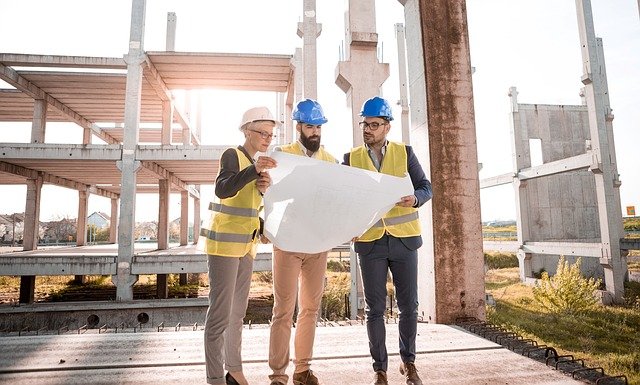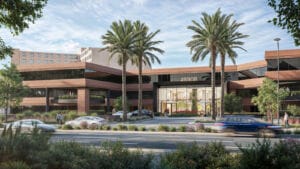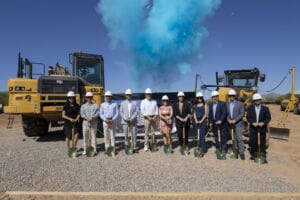The architecture profession in the U.S. is overwhelmingly white, with only 1 out of 5 new architects identifying as an ethnic or racial minority, according to the National Council of Architectural Registration Boards, a nonprofit licensing group.
Most graduates of university architecture programs also are white, with the National Architecture Accrediting Board reporting that 18% of 2019 graduates were Hispanic/Latino, 9% were Asian and 5% were Black.
The architecture program at Arizona State University is trying to change the profession by more closely aligning with the university’s charter: broadening access, increasing support and better preparing students for careers, according to Marc Neveu, head of the program.
READ ALSO: Ranking Arizona: Top 10 architecture firms for 2021
“There is no other architecture program in the U.S. that is based on the idea of being inclusive rather than exclusive,” said Neveu, who also is a professor of architecture, which is in The Design School at ASU.
“Every program in architecture is about being exclusive.”
One change will be in the curriculum. ASU’s Master of Architecture is considered a professional degree program that leads to licensure, while the Bachelor of Science of Design degree has been considered nonprofessional.
“What we’ve done is taught the entire thing as a professional program, which doesn’t leverage ASU in any way. It mimics the rest of the world,” Neveu said.
“So we rethought what an a nonprofessional degree program would be, with ways of thinking, ways of making, ways of learning, collaborating and innovating.”
The undergraduate programs will be “the architecture of,” he said, such as the architecture of systems, the architecture of music, etc.
The undergraduate program also has been accepting more students, growing from about 350 students three years ago to more than 700 next year.
Neveu said the goal is to change the profession, which is already happening in many architecture firms in the Valley.
“They are thinking about the entire building environment, not just the building,” he said.
“They’re thinking about real estate development, construction management, facilities management, the entire breadth of the built environment.”

The graduate program has been streamlined to encompass 12 units per semester, with students encouraged to pursue an additional credential, such as in construction management or real estate development.
Not only will that revised curriculum better equip students to enter the profession, it also will allow them to work while in school because they’ll have full days without classes, Neveu said.
In addition, the program will support student success.
“In most architecture programs, especially the one I went to, it was all about weeding out the ones who couldn’t cut it. Our attitude is the opposite. We want to support everyone,” said Neveu, who has been at ASU for three years.
“We don’t promote staying up all night. We don’t promote doing architecture and nothing else.
“We want to create a more holistic experience for students and that is unique in the United States.”
Shifting perspectives
Another way that the program will provide more access is by offering an online Master of Architecture degree, which will launch in the fall.
Neveu said that the pandemic shifted many people’s attitudes about online degrees, including the faculty.
“Two years ago … the idea was that maybe it was OK for a history class or some software classes,” he said. “But after the pandemic, we voted unanimously to launch an online program.”
The reimagined program has been in the works for many months and has been a collaborative effort among the faculty. The new online format has resulted in a unique set of applicants, he said.
“Now that we’ve opened up access, the applicants read like a bunch of success stories,” he said. “Someone battled cancer and now wants to be an architect. Someone worked 25 years in a job they didn’t like and they can’t move but now will get that architecture degree.”
Working on-site
Another way the program is better preparing students is by immersing them in the actual construction process through a new design-build studio course. The students meet with an actual client, design the structure and then participate in the construction, according to Catherine Spellman, a professor of architecture who taught the course.
Initially, the studio intended to build some structures at Camp Tontozona, an ASU facility in Payson used by a nonprofit children’s camp, but that project was derailed by the pandemic. So the studio course’s first client was ASU, and the project was an outdoor classroom on the Polytechnic campus.

Ideally, the architecture program will create a separate but affiliated nonprofit entity to run the design-build projects that would take on the liability and licensing required when students are doing the actual construction. That’s still in the works. So for now, the students have been working closely with the contractors and tradespeople who are doing the building.
“If you build on an ASU property, it needs to last a long time and be up to the standards of ASU, which meant that the shade structure needed to be built in steel, which is very heavy and cumbersome to construct with,” said Spellman, who also is the associate director of the architecture program.
“So ASU hired a construction company to build the project under the agreement that every trade and profession along the way agreed to work with the students, meeting them, having them come to their shops, allowing the students to interview them and take video of everything.”
The students drew up the construction and legal documents, built several models and, when construction started, were on site every day.
That experience more closely resembles what professional architects and construction managers do, Spellman said.
“Even the general contractors aren’t in the business of swinging hammers. They run the business and oversee the construction and make sure the schedules line up and everything is safe,” she said.
The design-build program is called Orange Build. Spellman said that the faculty limited the students in the courses to a palette of only black, white and gray for their drawings and models.
“Anything they wanted to highlight was done in orange. If you do something exceptional, it’s in orange,” Spellman said.
“This will be exceptional.”
Master’s degree students typically work in an architecture firm for a summer, but even that doesn’t provide the same experience as Orange Build.
“Most projects take years and they only see three months,” she said.
“But here it’s been a small enough scale that they’ve seen a whole range of trades.”
That hands-on experience improves the design process.
“Until you understand how something is put together, your design remains abstract. When you see the possibilities for how one construction material connects to another not just in a book or in software but on the site, you’re able to design at a much higher level,” she said.
Juan Felipe Mesa Rico, an assistant professor of architecture, taught the course with Spellman.
“Normally as an architecture student, you are just doing representations, but never really going and building with steel and bricks and concrete, or talking with communities and understanding what people need and want,” he said.
“People don’t always want what the architect wants to offer. You have to have an agreement.”
Neveu said the design-build studio highlights the “architecture-plus” vision of the redesigned program.
“The typical version is you work on a project with a faculty member and that faculty member is the client, and the critic and everything. It’s a one-on-one conversation,” he said.
“And the reality in practice is that when you graduate, you’re never just the one designer. That doesn’t happen. The practice is inherently interdisciplinary.”
The course is offered to fourth-year undergraduates and second-year graduate students, who supervise the undergrads. Yanela Nunez Ventura, who graduated with her master’s degree in May, was one of them.
“It was very helpful. Something we had to be aware of is that time is difficult to manage,” she said.
“There were days when construction had to stop because of a mistake or something wasn’t working right or a contractor didn’t show up in time. We realized it’s a very flexible process with so many variables we needed to adapt to and be prepared for.”
Nunez said it was good for the master’s degree students to learn how to manage teams.
“If you have your own firm, you have to organize and practice leadership skills,” she said.
Neveu said the reimagined architecture program also will explore ways to reach K–12 students, possibly by starting a design-build studio for high school students.
“The architecture and construction fields are not diverse,” he said. “We’re thinking about how we could create scalable courses that diversify the pipeline into architecture.
“Everyone wants to build things. It’s inherent in us as children, and we want to tap into that, and especially for students who are underrepresented in architecture.”




